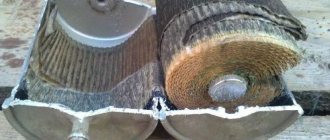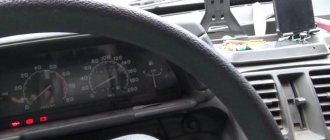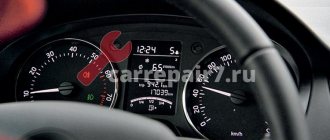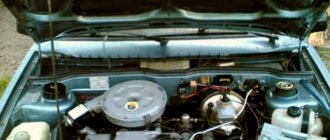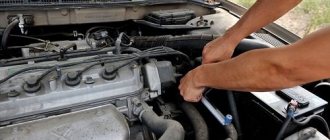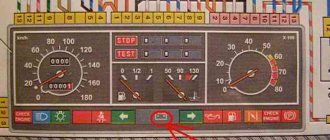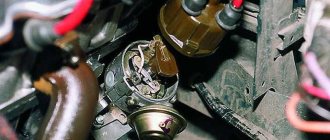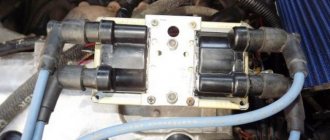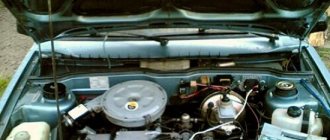VAZ engine
Sometimes such a nuisance happens on the way, the driver finds himself in a situation where the engine of a VAZ 2109 stalls in the middle of the road and it is impossible to start the car further. The most interesting thing in such a situation is that there were no traces of any signs warning (foreshadowing) these problems, the car drove as usual, there was no “sneezing” or “shooting in the muffler.” Since the problem is common, our instructions will tell you what to do in a situation such as a sudden stop of the engine and poor starting. We will consider in detail all the main reasons that cause the engine to stop at idle and while driving. And also the reasons why it does not start when warm and how to solve this kind of problem.
The engine choke when you press the gas VAZ 2109 carburetor
A fairly common situation during the operation of a vehicle is when failures occur when pressing the gas pedal, the engine stalls when over-accelerating, the power unit does not pick up speed, choke, etc.
Let's start with the fact that there can be many possible reasons for this type of malfunction. In the process of initial diagnosis, an important condition is the observation of characteristic symptoms, which allows you to more accurately and quickly determine the malfunction. Next, we will look at why the engine stalls when you press the gas pedal, as well as in what cases the engine stalls when you press the gas.
The engine stalls when you press the gas: possible reasons
As already mentioned, certain signs allow you to localize the existing problem. For example, if the engine stalls when “cold” after pressing the gas pedal only when the humidity outside is high, moisture may well be the cause.
- The problem is that water particles can accumulate on the distributor cap. Such accumulations of moisture settle on the inner surface of the lid in the form of condensation. Let us add that on some cars the cover is shaped in such a way that allows current to pass through the distributor, that is, the discharge is simply not supplied to the spark plugs. At the same time, at idle, the internal combustion engine operates normally, but when you press the gas, the problem manifests itself. This is explained by the fact that the distributor, at the moment of gas supply, begins to operate in an accelerated mode, passing a larger amount of electricity. Taking into account the fact that moisture has accumulated in the distributor housing, a malfunction immediately occurs and the engine choke, as a weak spark is formed at the spark plugs. To check, it is enough to observe whether such a failure is present on a warm engine, and also whether the malfunction appears when it is dry outside. You can also put the car in a heated garage or parking lot for several hours, and then evaluate the stability of the internal combustion engine after starting and at the moment you press the gas.
- Another reason why the unit may choke is that there is no vacuum in the fuel system. In other words, air leakage occurs, which affects the fuel pressure and the composition of the fuel-air mixture. Usually the problem progresses gradually and can occur on both a cold and hot engine. The fact is that in order to accurately determine the amount of fuel supplied at a specific point in time, the vacuum in the fuel system plays an important role.
Let's sum it up
Fine cars with carburetor engines have become industrial history, but they are still widely represented on the roads. That is why you can use the ideas presented in this publication, since there are still a lot of carburetor masters, and you can find the necessary spare parts in stores. If your car has problems with the quality of the fuel supply system, it’s time to fix all these problems. You can quite easily obtain high quality operation of the power unit and fuel system if you simply take care of all the important components of the car.
For the carburetor to work properly, it simply needs to be cleaned occasionally. This point is quite important for every car operating in Russia. Fuel quality, atmospheric pollution - all this affects the normal operation of the engine. It is enough to carry out a high-quality cleaning of the fuel supply system every few years by performing certain maintenance processes to ensure long-term and high-quality operation of all engine systems. How did you maintain a carburetor car?
Carburetor or injector
While the whole world has made a choice in favor of injection engines, in our country the intensity of the debate on the topic “injector or carburetor” does not subside. Mostly, the debate revolves around the possibility of field repair of an engine with a carburetor or an injector. Adherents of the first passionately prove that a failed carburetor engine can be easily repaired literally “in the open field.” And if the injection engine fails, prepare a tow rope and go to the service center.
Proponents of injectors raise the objection that injection engines break down much less often, and there are only two typical malfunctions.
- Damage to the crankshaft position sensor.
- Fuel pump failure.
At the same time, the “injection guys” rather sarcastically clarify that the fuel pump can just as easily break down on a carburetor engine, and the sensor costs a penny and can be easily changed even in the field. Perhaps we should admit that the supporters of injection are somewhat right. But if you happen to drive a carburetor version, then you shouldn’t chase the illusory savings of a glass of gasoline per 100 kilometers. You shouldn’t start switching to a new type of power system just because the VAZ 2109 carburetor failed when you pressed the gas pedal.
If something happens, the carburetor “nine”, even if it sneezes in blue puffs, even with a sinking accelerator pedal, will take you home - after all, it’s worth something.
Accelerator pump failure
What causes problems with the accelerator pump:
- Incorrect spray dosage or channel blocked by debris.
- Worn (torn) diaphragm.
- The pump drive is incorrectly selected.
Factory-made sprayers have two strokes directed into the chambers. Most experts are sure that the second “spout” in this system is superfluous, so you can install a sprayer with one stroke, as, for example, on the Niva.
You need to check the presence of the atomization process by removing the carburetor and unscrewing the top cover. In this case, fuel must be filled into the float chamber. The throttle valve opens, and two jets pass through the lower part of the housing without touching it - this is a sign of serviceability.
Ozone or Solex
With the start of production of the VAZ 2108 and 2109, AvtoVAZ designers abandoned the use of Ozone carburetors, in which many complex options had no practical meaning. What was the cost of the forced idle economizer alone, which supposedly served to save fuel during engine braking? Neither engine braking became widespread, nor did the EPKH bring any noticeable savings, but it provided drivers with quite a few headaches when pressing the gas.
When switching to “eights” and “nines”, the plant returned to a simpler version of the carburetor. It was distributed under the name Solex: after the name of the French company that produced its prototype. Solex lost the pneumatic drive for the secondary chamber damper, a semi-automatic starting device, and an autonomous idle system.
The design has been simplified and reliability has increased. It is Solex that, as a rule, owners of carburetor versions of the VAZ 2109 deal with.
Removing the device
If you nevertheless determine that the idle speed sensor is broken, then you will need to replace it with a new one. To dismantle this part, no special skills are required. The above-mentioned VAZ 2109 and 21099 sensor is installed on the throttle body body and attached to it with two bolts, for example, like a fuel pump. In order to remove this device, it is enough to unscrew the two mounting bolts and remove the bundle of wires connected to the device. Before performing this work, it is recommended to disconnect the battery by removing both terminals from it.
Non-carburetor causes of engine failure
Car owners usually refer to failures as unpredictable short-term interruptions in the operation of a car’s internal combustion engine. Failures belong to the category of so-called “unreasonable”, or, more precisely, multi-cause failures. It is impossible to say unequivocally about such breakdowns: failures appear - change the spark plugs. More precisely, it is possible to say, but it is not a fact that after replacement the failures will disappear. Although this also happens.
So failures in the operation of a carburetor engine are not necessarily related to the device itself. And before you start working on such a complex unit, you should exclude the influence of other reasons.
- Mechanical failure of the drive.
- Ignition system malfunctions.
- Failures of the power system located outside the carburetor.
These groups of negative factors stand out among others. Let's look at them in detail.
| Malfunctions | Your actions |
| Mechanical failures of the drive include, first of all, a faulty throttle cable. | It simply needs to be replaced. |
| In the ignition system, spark plugs most often fail. | Excessive carbon must be cleaned, faulty spark plugs must be replaced. |
| High-voltage wires fail a little less often. | It is not recommended to check the spark “to ground”; this is dangerous. You should measure the resistance of the wires using an ohmmeter and make sure that it corresponds to the nominal value. |
| Excessive wear of the carbon contact in the distributor cover. | Rule out this reason. |
| If everything is in order with the ignition system, and the engine still fails when you press the pedal sharply, move on to the power system. | Most often the fuel pump fails. Start with an inspection of this particular unit. |
Remove the outlet pipe from the fitting. Press the fuel pump manual drive lever vigorously. There should be an intense stream of fuel coming out of the hose. If not, the pump is faulty and must be repaired or replaced. Clean the fuel line filters from the tank to the carburetor, and blow out the pipelines themselves.
If everything is in order with the power and ignition systems, move on to the carburetor itself.
What to do if cars with automatic transmission stall?
If your vehicle has an automatic transmission, then the problem should be found in the electrical supply. If you abruptly switch from one gear to another, or while switching gears while braking, the settings may be distorted, and the on-board computer will receive a signal to turn off the engine.
Also, models with automatic transmission may stall due to malfunctions of the hydrodynamic transformers of the gearbox. This problem mainly manifests itself during acceleration and requires urgent intervention from car service specialists.

